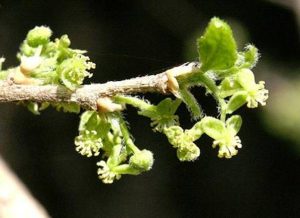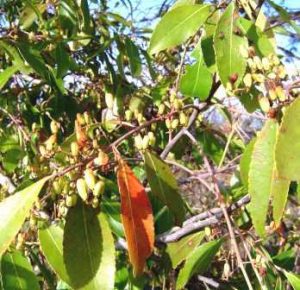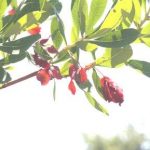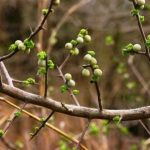TREE LIFE
June and July 1996
Subs ($40) for the year 1996/97 were due on 1st April. If you see a red dot on your Tree Life, it is to remind you that payment has not been received and that this will be the last issue that we can send you.
MASHONALAND CALENDAR
Saturday 6th July. Botanic Garden Walk at 10.45 for 11 a.m. We will meet Tom in the public car park of the Gardens. If there is a topic which particularly interests you, let us know. There will be a guard for the cars.
Sunday 21st July. The Great Dyke is an interesting phenomenon in many respects, and this month Rob Croukamp will tell us something about the mineral content of the Dyke and explain the methods used to extract chrome ore. The vegetation too, is very interesting in spite of heavy concentrations of nickel, magnesium and other metals the Dyke is home to several endemics such as Ozoroa longipetiolata, Rhus wildii and Aloe ortholopha. Meet at 9.30 a.m.
Sunday 27th July. In place of Mark’s Walk during the 3 winter months starting July, we be showing the remarkable videos by David Attenborough entitled The Private Life of Plants. The plan is to break for tea between Parts 1 (Travelling) & 2 (Growing). The venue is Chisipite Girls High School. Bring your own refreshments for the break. Each part takes about ¾ hour so we expect to be on our way home well before 5 o’clock. we meet in the car at 2 o’clock.
Saturday 3rd August. Botanic Garden Walk.
MATABELELAND CALENDAR
Sunday 7th July. All day or half-day according to preference, Leopard Rock Kopjie area, Khami River. Meet in the Girls’ College car park for an 8.30 a.m. departure.
August 8th – 12th. Visit to Buchwa Mountain. Accommodation for 20 people will be at the Buchwa Iron Mine Guest House. Fully booked, but there is a waiting list in case of cancellations. Please phone Anthon Ellert in the evening or Maureen Silva-Jones in the evenings to book or for further information.
SHOSHANI DAM – 2ND JUNE 1996.
After gathering at the usual rendezvous, 15 of us set off for Shoshani Dam which was reported to be fairly full. We proceeded in convoy down the Plumtree Road for 70km and shortly after reaching Marula turned left onto a dirt road (not too bad) and travelled a further 40km or thereabouts. The day was bright and sunny with a stiff breeze blowing.
On arriving at the Dam we were very pleased to find it resembling ‘lake-like’ proportions with vistas of water stretching back for some km – such a thrill to see, as when we last viewed the dam it was still under construction and totally empty. It’s only partially full but looking good anyway.
The dam wall was, until recently, the longest in Zimbabwe but has now been overtaken by the Odzi Dam in Manicaland in this respect.
After looking our fill at the dam we went for our tree walk. The surrounding veld is still looking green and lush – very much better than it has looked for some six years.
Accompanying us on our walk were some svelte looking cattle and even the goats appeared to be in excellent condition. One very large fellow with fearsome horns looked as if he resented our intrusion upon his lunch and turned a baleful eye in our direction, whereupon some of us beat a hasty but dignified retreat.
We climbed a kopjie on the right flank and the view of the Shoshani was magnificent – just like Switzerland! Many species of trees were observed. Some of our members collected several attractive pods – i.e. Lucky Bean and the lovely Wooden Banana pods.
After finally managing to round up the stragglers and lost member in charge who had been away upon their own botanical missions, we returned to the dam and found a lovely shady picnic place, again amidst some inquisitive livestock. We had a festive lunch and then made our way homewards. The road is a very scenic one with weird and wonderful rock formations along the way – one of which is the famous Miss Piggy.
All in all it was a super day.
-Jill Wild
MHOWANI HILLS AND A.G.M. 19th MAY 1996.
After tea and eats in a delightful thatched reception area, then a speedy A.G.M. in the sunshine, we moved on to the base of Mhowani Hills kopjies. Here we based on the rock slide of a small stream – now just a few pools, some of us to sit, Kenneth to prize off rock slabs in search of scorpions, and others to try out Meg’s new key.
Our first tree was Pappea capensis, Lobengula’s Indaba Tree, the fruit of which is quite wonderful to eat. They taste like grape juice and have a single large pip to spit out. Trying to key this out again now, I’ve gone miles off by putting “leaf margins serrated, toothed or scalloped” instead of leaf margins more or less entire, “may be wavy” but of course only the young leaves are really toothed. Happily, “leaves spiralled” or “alternate” both lead to the same answer, though the former more directly. A Terminalia sp. proved troublesome. Intuitively we wanted to call it Terminalia stenostachya but Meg said it would key out as Terminalia sericea. (It helps to have the author along). It had peeling twigs, leaf scar craters, pink petioles and the leaves larger and greener than those normally associated with Terminalia sericea.

Erythrococca trichogyne. Photo; Mark Hyde. Source: Flora of Zimbabwe
The lunchtime excitement was Kenneth’s mottled grey and pink gecko which promptly shed its tail once in his Consol jar. In the afternoon we took a leisurely scramble up the one kopjie to see the rock paintings at the top, passing Heteropyxis dehniae, Erythrococca trichogyne and Tricalysia niamniamensis (sounds like the plane start up on the Wrex Tarr record). Really we enjoyed the view, the yellow leaves dropping from the Sterculia, the flaking bark on the Commiphora marlothii and the silhouette of the fruiting Commiphora mollis. Last holidays I watched a friend doing his fire from twigs trick – not easy. Amazingly he used Commiphora mollis for both the notched base twig and the rotating downward spike. I had always imaged one needed to be a hard wood and one a soft wood. One of the secrets was that he spliced a very smooth, very straight shaft twig onto his vertical Commiphora mollis end piece. The pressure and speed needed here obviously being crucial.
Our thanks to Mhowani Hills owners and Ken and Sue Worsley for hosting such an enjoyable day.
-Tessa Ball
From Wood Southern Africa/Timber Times May 1996. Vol.21 No.7.
YEBO TREES!
If all you tree experts out there have been wondering how a 35 m palm tree could have sprung up overnight in your neighbourhood, you need wonder no more. Cellular network service provider Vodacom has commissioned a number of heavily disguised masts for placement in urban areas in as effort to limit their impact on the environment.
The masts are close replicas of the Cocus primosa, a tree which grows to a height of 35 m according to Vodacom group executive corporate affairs Joan Joffe, it is “almost impossible to tell from the real thing and fits in comfortably with the fauna typical in an urban environment”.
The trees are constructed of fibreglass and painted with tree markings, with the characteristic rings and stumps of the Cocus primosa painted on the trunk. The green ‘leaves’ at the top of the tree disguise the antenna, while the base station container at the foot of the masts will be hidden inside an imitation boulder also made of fibreglass.
The first ‘tree’ was erected in Cape Town in March, while the first Gauteng palm can be viewed near the Pirates Club in Parkhurst. More camouflaged masts will be going up all around the country.
According to Joffe, base stations in the Kruger Park will be disguised inside thatch huts similar to those found in rest camps throughout the Park. But we can’t help wondering… will we ever again be sure that the giraffe staring fixedly at us from behind a palm (?) is actually a giraffe.
YEMENI HABIT OF CHEWING THE QAT EXACTS HEAVY ECONOMIC TOLL
Farmers grow rich on it; consumers get high on it, and governments revenues are swelling by taxes levied on it. But the natural penchant for chewing the leaves of a small bush called Qat is distorting the Yemeni economy.
In a country almost the size of France, where only 3% of the land can be cultivated, somewhere between a third and a half is devoted to the cultivation of qat – the so-called vice of the Red Sea. Chewing qat is as much a habit in Yemeni as drinking beer is in Britain. It is easy to grow, it sells for a high price, and more and more farmers are being lured into abandoning traditional agricultural products for the substantial financial rewards that qat bring.

Catha edulis. Photo: Brt Wursten. Source: Flora of Zimbabwe
Qat or Catha edulis foisk contains a natural amphetamine called cathinone. Its bright green leaves are chewed in cuds until they become a paste. The juice is either swallowed or spat out. Over several hours, a large ball accumulates in the cheek, making the chewer appear as if he has a billiard ball in his mouth.
To the uninitiated, qat tastes a bit like privet; extremely bitter and very unpleasant. Yemenis, who have consumed qat for hundreds of years, insist, however, that the ‘magic leaf’ makes them feel happy and alert. Moreover, it is an alternative to alcohol acceptable in the Koran.
The economic consequences of qat cultivation are becoming increasingly serious, however. Yemen imports more than £389 million in food a year, almost half the value of Yemen’s current account deficit, due to the scarcity of fertile land, and the excessive amount given over to qat.
Moreover, the working day stops at about 1 p.m., so that the estimated 90% of the population who indulge in the habit can haggle over the price in the qat markets, and then retire to chew the leaves. This has a big effect on productivity.
During Britain’s days as a colonial power in Aden, attempts to ban the consumption of qat proved futile, and usually ended in riots. But fears that qat was a narcotic proved unfounded. According to a 1980 United Nations report, however, prolonged chewing of qat could lead to dental and gastric diseases, cirrhosis of the liver, loss of sleep, hypertension and cerebral haemorrhage. Studies published in the Lancet have also suggested that it can lead to violent behaviour and paranoid psychosis.
Qat has been banned in the United States, Canada, Scandinavia, France, Italy, Morocco and Saudi Arabia; it remains widely used, however, in Yemen, Ethiopia, Somalia and Kenya. It is even exported to Britain, one of the few western countries where it has not been banned, to meet the demand of the immigrant communities.
The high profits make it pointless for farmers to cultivate anything else. There seems to be no antidote for the mild stimulant, which exacts a heavy toll on national economies and the health of consumers.
-From Michael Dynes in Sanaa – The Times 13/1/96
Recently there have been requests to give little pointers for plant family identification, so wherever space permits there will be an article or two on the families. The extracts will be from one of my favourite books called Flowering Plants of the World. The consultant editor is V.H. Heywood to whom we acknowledge our thanks.
Annonaceae
The Annonaceae is a large family of chiefly tropical trees and shrubs, some of which are used for their fruit.
Distribution. Found throughout the tropics, the Annonaceae species are especially characteristic of lowland evergreen forest in several parts of the Old World tropics.
Diagnostic features. All but one species are trees or shrubs, sometimes climbing, usually evergreen, with resin canals and septate pith in the stems. The entire leaves, arranged in two ranks, without stipules, are often recognizable in the field by a glaucous or metallic sheen. The fragrant flowers, often nodding, frequently open before all the parts are fully developed. They are regular and bisexual rarely unisexual). The perianth is usually in three whorls of three and the stamens are usually numerous and spirally arranged, rarely few and whorled. The carpels are usually separate, the fruit being an aggregate of berries, the fruits of Annonaceae species are worth eating because the berries coalesce with an edible, fleshy receptacle. The fruits are attractive to bats, squirrels and monkeys. The flower in many species acts as a trap for pollinating beetles.
Classification. Although its limits are well defined, the family is notoriously difficult to divide into natural groupings of genera. Two genera, Monodora and Isolona of Africa, have syncarpous ovaries and are separable as the subfamily MONODOROIDEAE. The other family, ANNONOIDEAE is divided into 6 tribes. The larger genera include the pan-tropical Xylopia (about 150 species) the Old World Uvaria (about 100 species), Polyalthia (about 100 species), Friesodielsia (about 50 species) and Artabotrys (about 100 species of climbing or erect shrubs with inflorescences borne on hook-like peduncles). The American Annona (about 100 species, a few in Africa) and Monanthotaxis with 56 species in Africa and Madagascar.
The Annonaceae is one of the groups of primitive families of flowering plants sometimes termed the Annoniflorae, often with indefinite numbers of free floral parts and spirally arranged stamens.
Economic uses. South American species of Annona were early introduced to the Old World for their fruits (notably soursop and sweetsop), though those of the Old World Artabotrys are edible too. The aromatic oils characteristic of the family gives ylang-ylang from the flowers of Cananga odorata, and the perfume of Mkilua fragrans is used by Arab and Swahili woman. The spicy fruits of the West African Xylopia aethiopica are the so-called “Negro pepper” used as a condiment, and those of Monodora myristica of the same area are used as a nutmeg substitute. Although some Xylopia woods are used, the timber is of little importance, except for pliable lancewoods.
-D.J.M.
Some woody Annonaceae occurring in Zimbabwe and their distribution:-¬
Uvaria gracilipes (S)
Uvaria lucida (ES)
Cleistochlamys kirkii (NES)
Friesodielsia obovata (NWCES)
Hexalobus monopetalus
var. monopetalus (WS)
var. obovatus (NCES)
Xylopia aethiopica (E)
Xylopia odoratissima (NW)
Xylopia parviflora (E)
Artabotrys brachypetalus (NWCES)
Artabotrys monteiroae (E)
Annona senegalensis (NES)
Monodora junodii (NES)
Origins and meanings of some of the genera: ¬Uvaria – from the Latin uva – cluster of grapes.
Friesodielsia – Commemorating E.M. Fries, 1749-1878 (129 years old?) and F.L.E. Diels 1847-1945 – director of Berlin-Dahlen garden.
Hexalobus – from the Greek hexa-, six; lobus, lobe.
Xylopia – from the Greek xylon, wood -opia eyed (?) or pikros, bitter(?)
Artabotrys – artana – Greek for “that by which something is hung up, botrys – a cluster of grapes.
Flacourtiaceae
The Flacourtiaceae is a large family, chiefly of trees and shrubs, and of limited economic importance. Distribution. The family is widespread in the tropics and subtropics, with some species in temperate regions.
Diagnostic features. The leaves are simple, alternate, opposite or in whorls, toothed or entire. The branches are sometimes spiny, and flowers are regular, bisexual or unisexual with the sexes on separate plants. They are solitary or borne in axillary or terminal inflorescences. There are two up to 16 sepals, free, overlapping or contorted, sometimes intergrading with the petals in appearance. The usually overlapping or contorted petals, sometimes united, are normally rather small and the same number as the sepals, rarely more and then not arranged in relation to the sepals, or rarely absent altogether. The stamens are frequently numerous or sometimes the same number as and opposite the petals. The ovary position varies from superior through semi-inferior to inferior. The styles may be fused or free. The fruits are capsules, berries, drupes, dry indehiscent and winged, horny or prickly, and containing seeds sometimes with arils or silky hairs and usually with much endosperm.
Classification. On the basis of floral characters 12 tribes have been recognized. Chief genera are: Erythrospermum (6 species), Hydnocarpus (40 species), Scolopia (45 species); Homalium (200 species); Flacourtia (15 species); Azara (10 species); Xylosoma (100 species); Casearia (160 species).
Economic uses. The family contains
few plants of economic importance. Notable ornamentals are Oncoba spinosa, Berberidopsis corallina, Carrierea calycina, Idesia polycarpa and Azara species. Hydnocarpus wightiana and Taraktogenos kurzii have seeds that yield chaulmoogra oil of use in the treatment of leprosy. The few timber trees include Gossypiospermum praecox – West Indian boxwood.
-B.M.
Woody Zimbabwean Species include
Rawsonia lucida (ES)
Oncoba spinosa (NWC)
Xylotheca tettensis
var. macrophylla (NS)
Kiggelaria africana (E)
Scolopia mundii (E)
Scolopia stolzii (E)
Scolopia zeyheri (NCWES)
Gerrardina eylesiana (E)
Homalium abdessammadii
ssp. wildemanianum (W)
Homalium chasei (E)
Homalium dentatum (WCES)
Calantica jalbertii (Bivinia jalbertii) (S)
Trimeria grandifolia (E)
Aphloia theiformis (E)
Flacourtia indica (NWCES)
Dovyalis caffra (WES)
Dovyalis hispidula (ES)
Dovyalis lucida (E)
Dovyalis macrocalyx (E)
Dovyalis zeyheri (WCES)
Casearia battiscombei (E)
Origins of some generic names:
¬Xylotheca – Greek xylo –woody, theka, case; the fruit is a woody capsule.
Scolopia – presumably from the Greek skolops – a stake or other pointed object – referring to the thorns on some species.
Earlier this year the Bulawayo and Harare Branches held their AGMs. The Committee members are listed below with their telephone numbers.
Bulawayo
Chairman Mr. A. Ellert
Secretary Mr. J. Timberlake
Mrs. C. Van Vliet
Gill Short 41541
Mrs. M. Ellert
Harare:
Chairman Mr. A. MacNaughtan
Treasurer Mrs. R. Greig
Secretary Mrs. M. Silva-Jones
Mrs. V. Siebert
Mr. M. Hyde
Mr. R. Manser
The 15th Congress of The Association for the Taxonomic Study of the Flora of Tropical Africa is being held in Harare from 5th to 9th February, 1997. It is being organized by the Institute of Environmental Studies at the University of Zimbabwe.
The organizing committee invite you to the next AETFAT Congress, the meeting place for botanists interested in the African flora and vegetation. The theme will be “Plant Biodiversity in Africa: its use and value to people”. The congress will include a workshop on the Convention of Biodiversity and a number of symposia.
Suggested topics for symposia, on which we welcome comments, include:
- Biology and evolution of forest plants
2. Pollination and reproductive biology
3. Phytogeography of the Zambesian, centre of endemism
4. Mapping of the African flora
5. Conservation of plant communities
6. Taxonomic concepts at the family level
7. Recent advances in generic and specific concepts
8. Biology and evolution of African petaloid monocots
9. Taxonomy of African crops and crop relatives
10. Ethnobotany and uses of African plants
11. Plant resources and sustainable development
12. Development of African herbaria.
During the course of the Congress there will be excursions to the Great Dyke and National Botanic Gardens. The Pre-Congress tour will be to Victoria Falls and Hwange National Park, while the Post-Congress tour will go to the Eastern Highlands. The Pre-Congress tour will cost US$850 per person for 3 nights while the Post-Congress tour will cost US$400 per person for 3 nights. Costs are inclusive of local airfares, bed and breakfast accommodation and local transportation. Zimbabwean botanists and ecologists will act as tour guides.
Accommodation is being arranged at the University Hostel, The Bronte Hotel, and at the Monomatapa Hotel, the costs increasing accordingly.
The registration fee is US$275 which will cover lunches, tea and coffee, workshop proceedings, abstracts, the tours to the Great Dyke and the National Botanic Gardens, and a conference dinner.
In order to start the planning process we are re¬quested to return the form as soon as possible.
Photo copies of this form can be obtained from the Tree Society on request.
Or communicate with F. Nengomasha, institute of Environ¬mental Studies, University of Zimbabwe, P 0 Box MP 167, Mount Pleasant Harare. Phone 303211 Ext. 1481. Fax 263-4-333407.
ANDY MACNAUGHTAN CHAIRMAN



